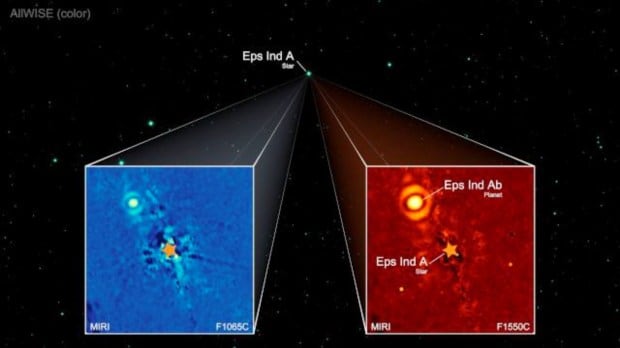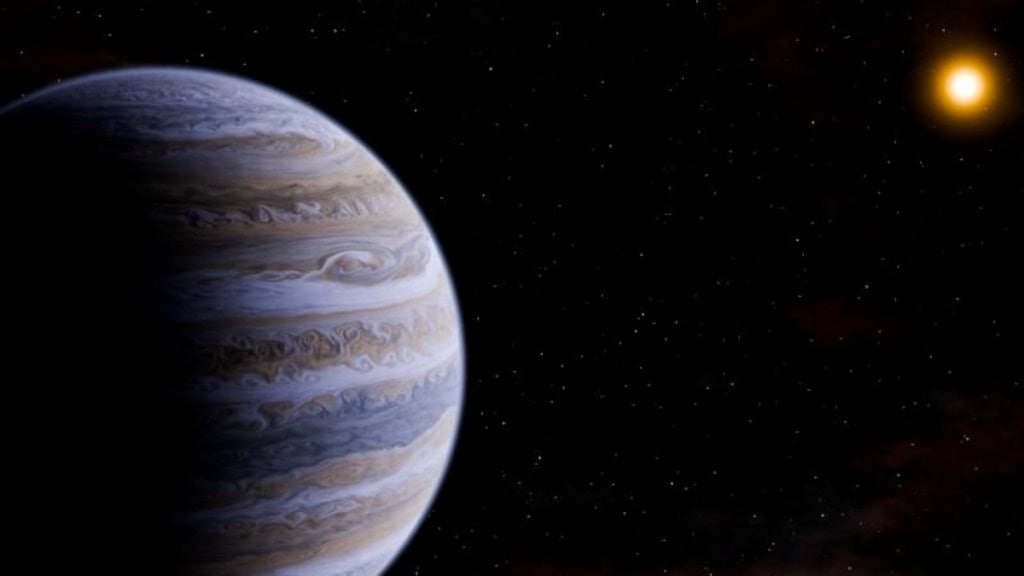In a remarkable discovery, an international team of astronomers, including Dr Prashant Pathak from IIT Kanpur, has identified a giant planet orbiting a star similar to our Sun. Named Epsilon Indi Ab (Eps Ind Ab), this “super-Jupiter” is the first mature exoplanet to be directly imaged using the James Webb Space Telescope (JWST). The findings, published in the prestigious journal “Nature’’, mark a significant milestone in space exploration.
The Discovery Process
The breakthrough was achieved using the JWST’s Mid-InfraRed Instrument (MIRI), which enabled the direct imaging of the exoplanet. Eps Ind Ab orbits the K5V-type star Epsilon Indi A, located approximately 12 light-years from Earth. Unlike traditional methods that infer the existence of exoplanets through gravitational influences or the dimming of starlight, direct imaging allows scientists to observe the planet itself. This technique is particularly challenging due to the overwhelming brightness of host stars, which can obscure the faint light from orbiting planets.
To overcome this, the team used a coronagraph on the JWST’s MIRI camera, effectively creating an artificial eclipse to block the starlight. This allowed the detection of faint signals from Eps Ind Ab. The planet’s proximity to Earth and the JWST’s advanced capabilities were crucial in this successful observation.

Characteristics of Epsilon Indi Ab
Eps Ind Ab is a super-Jupiter, boasting a mass at least six times greater than Jupiter, making it significantly larger than any planet in our solar system. It is relatively cold, with a temperature around -1°C (30°F), and orbits its star at a distance 28 times greater than the Earth-Sun distance. This vast orbit contributes to its lengthy orbital period of approximately 200 years.
The planet’s atmosphere shows an unusual composition, with a high metal content and a distinct carbon-to-oxygen ratio compared to planets in our solar system. These findings open new avenues for understanding planetary formation and evolution.
Insights from the Research Team
Dr Prashant Pathak, a key member of the research team, emphasized the significance of this discovery. “This discovery is exciting because it gives us a chance to learn more about planets that are very different from our own. By studying Eps Ind Ab and other nearby exoplanets, we hope to gain a deeper understanding of planetary formation, atmospheric composition, and the potential for life beyond our solar system.”
Elisabeth Matthews from the Max Planck Institute for Astronomy in Germany, and the lead author of the research article, highlighted the challenges and surprises faced during the discovery. “To our surprise, the bright spot that appeared in our MIRI images did not match the position we were expecting for the planet. Previous studies had incorrectly estimated the planet’s mass and orbital separation. With the help of the JWST, we were able to set the record straight.”
The Path Forward
The discovery of Eps Ind Ab is just the beginning. The next step involves obtaining spectra to provide a detailed fingerprint of the planet’s climatology and chemical composition. Thomas Henning, Emeritus Director at the Max Planck Institute for Astronomy and co-PI of the MIRI instrument, expressed the team’s long-term goals. “We hope to also observe other nearby planetary systems to hunt for cold gas giants that may have escaped detection. Such a survey would serve as the basis for a better understanding of how gas planets form and evolve.”
Global Collaboration
This discovery was made possible through a collaboration of researchers from renowned institutions worldwide, including the Max Planck Institute for Astronomy in Germany, the Space Telescope Science Institute in the USA, IIT Kanpur in India, and several other leading research organizations. This global effort highlights the collective pursuit of knowledge and the advancement of our understanding of the universe.
Bottomline
As astronomers continue to explore distant worlds, each new finding brings us closer to unravelling the mysteries of the cosmos and understanding the vast array of planetary systems beyond our own.
This pioneering discovery serves as a testament to human curiosity and the relentless pursuit of knowledge, inspiring future generations of scientists and space enthusiasts alike.
